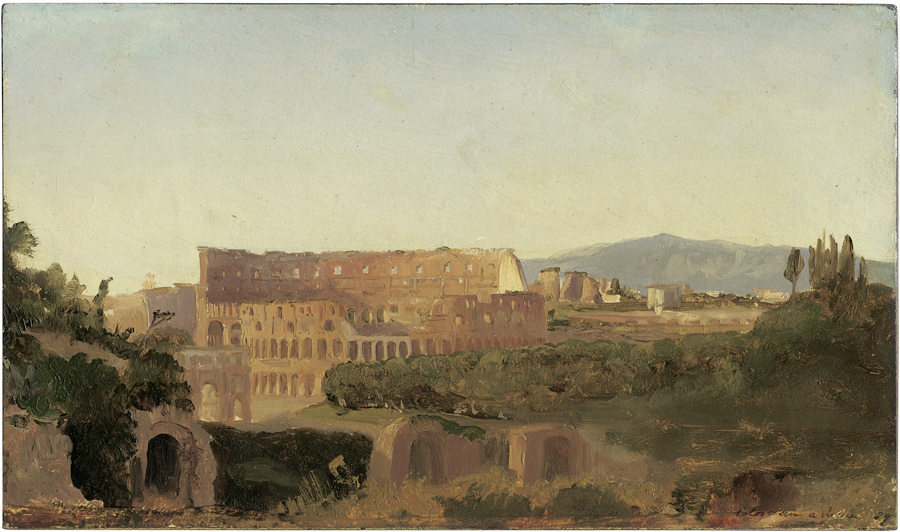Loading the page ...
Carl Blechen
(1798 Cottbus – 1840 Berlin)
View of the Colosseum in Rome from the Palatine Hill. Oil on paper, mounted on panel. 31.9 x 18.7 cm. Inscribed and dated by the author: “Colosseum a Roma (18)29”.
This superb, atmospherically subtle oil study of the Colosseum in Rome is a valuable addition to the oeuvre of Carl Blechen. It is a genuine rediscovery, as it was unknown to Paul Ortwin Rave, the compiler of the still authoritative catalogue of Blechen’s work, which first appeared in 1940. In the autumn of 1828 Blechen had set off for Italy in pursuit of an inner personal desire. His journey to the south was to last just over a year. He followed the usual route taken at the time by artists and cultural tourists, which took him from Venice through the towns of central Italy to Rome, where he arrived in early December 1828 and stayed for five months. Once in the città eterna, he was immediately taken in by the German and foreign artistic community there. Blechen frequented a popular artists’ haunt, the prestigious Caffè Greco near the Spanish Steps, which still exists today. He lived in the same house as Joseph Anton Koch, the doyen of the German artistic community, and Johann Christian Reinhart, and attended joint drawing sessions of German artists. At the beginning of May 1829 Blechen set off for Naples, where he lived and worked for about two months. He went on many expeditions to explore the picturesque surroundings of the southern Italian capital. The Italian journey was a formative and liberating experience in Blechen’s life, triggering a radical change in his creative work. The numerous study sheets and oil studies he produced in Italy heralded a new interest in openair painting and are appealing for the freshness and directness of their approach to nature, see ill. p. 90 and 92. Blechen’s evident gift for rendering the southern light, which he cleverly captured using vivid chiaroscuro effects in all his different tonal values, links him with such contemporaries as the Norwegian painter Thomas Fearnley, the Frenchman Jean- Baptiste-Camille Corot – who was in Rome at roughly the same time – and German colleagues like Friedrich Wasmann, Johann Martin von Rohden and Ernst Fries.
The present study shows a view seen from the Palatine Hill in a north-easterly direction. The viewer’s gaze is led from three round-arched openings of a ruined building in the foreground via the only partly visible Arch of Constantine towards the Colosseum, whose huge arcades and weather-beaten walls are painted with great artistic subtlety in a mild, early evening light. On the right, behind this landmark of Ancient Rome, we glimpse the outlines of Trajan’s Baths on the Colle Oppio and other structures, which are sketchily but vividly rendered. On the horizon we see the hazy, bluish-grey shapes of the Sabine Hills beneath a clear, pale blue spring sky. The faithful and simple rendering of light and colour is the pre- dominant theme of the picture, the artist having deliberately dispensed with any anecdotal message. Similarly, the long narrow format suggestively emphasizes the majestic sweep of a townscape that goes back thousands of years.
Stylistically the painting fits neatly into the work of Blechen’s Roman period. Several oil studies produced in 1829 show a comparably temperamental and reductionist style and use of colour. A small-format oil study, the Tomb of Cecilia Metella (Berlin, Nationalgalerie) reveals similarly economical, but effective brushwork; the pale blue of the sky, slightly mingled with yellow, closely resembles the colouring of our study. There are, however, only a few views of specifically Roman ruins in Blechen’s work, as in Rome he mainly adopted motifs from the immediate environs of the city. Stylistically closest to the present painting (also as to format) is the oil study Die Ruinen des Septizoniums auf dem Palatin (Rave 811), which is to be found in the Oskar Reinhart Foundation in Winterthur. An oil study much larger in format is Das Forum Romanum (Rave 810) in the Österreichische Galerie in Vienna. The pen inscription below right “Colosseum a Roma 29” is, in the view of Professor Helmut Börsch-Supan, certainly an autograph. An inscription comparable in style is discernible both on the Portrait of Francesca Primavera from the same year (Rave 1569, formerly Walther Unus Collection, Berlin) and on numerous drawings produced in Rome (Rave 712–714, 716, 717, 719–720, 723–725, 733–735, 769, 773–775, 777, 780, 782–783).
Blechen’s small-format works in oil on paper raise the question as to whether these oil sketches are to be regarded as preparatory studies or as paintings in their own right. The careful composition of our picture would seem to support the second assumption. After his return to Berlin, Blechen’s landscape sketches were greatly prized in select collector circles and no less a figure than Karl Friedrich Schinkel praised them as “something real in art” and “little pictures” (Jutta Schenk-Sorge, “Neapel sehen und malen!” in Carl Blechen. Zwischen Romantik und Realismus, Berlin, 1990. p. 40).
An appraisal by Prof. Helmut Börsch-Supan, dated 24 March 2012, is enclosed.
